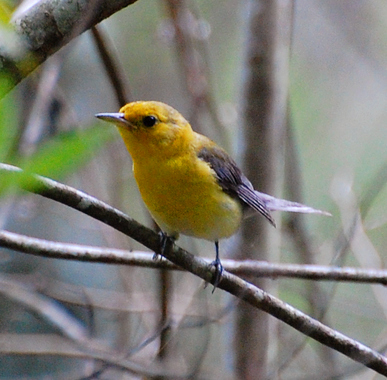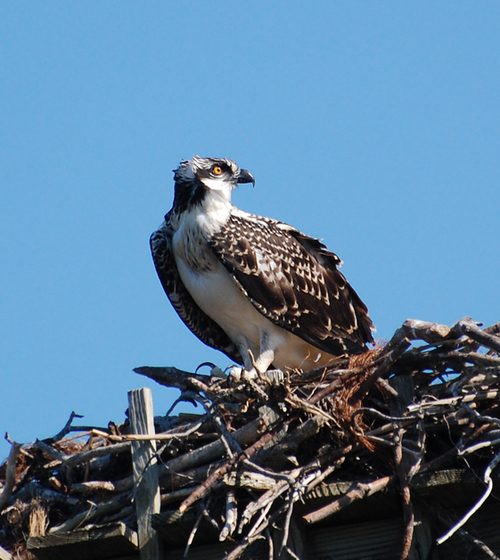
A face only a mother could love
July 17th, 2010
And now for a change of pace...


Photographed at the Manteo Aquarium. I was amused by this guy's curmudgeonly expression.
One good tern...
July 16th, 2010
While I was out on the river yesterday photographing sandpipers, a nearby pair of Common Terns was angrily harassing a gull. And they seemed none too happy about me, either--circling directly overhead, kee-arring loudly. So I took the hint, got a few good pictures and left.
Terns are largely oceanic birds, but this is one species that lives inland as well.


It wasn't until I looked at my photos back home that I realized why the pair was so defensive: they had a young un'! Standing on a little islet, apparently begging his parents for food. I didn't realize terns bred in that area.

( Terns of Outer Banks )
A present-day interlude
July 15th, 2010
So, remember how I said sandpipers migrate really early?

Least Sandpiper
Low water levels on the Ottawa River have left behind extensive mud flats. This is great news for those of us who want to go shorebird-watching in late summer. Sandpipers and plovers are attracted to that kind of habitat, sometimes in large flocks. And even though it's only mid-July, the first wave of migrants shorebirds is now moving through.
At Andrew Haydon Park yesterday, a flock of several dozen Least Sandpipers was foraging in the mud and shallow water. This is one of an informal class of birds known as the "peeps": very small (sparrow-sized), very cute sandpipers that can be hard to distinguish from each other. Least Sandpipers are the easiest of them. They're the only ones (in our area) with yellow legs instead of black ones.

A few Semipalmated Sandpipers were mixed in with the flock. They're a little grayer and a shade bigger, but leg color is the most reliable difference.
Other early migrants included one Semipalmated Plover and one Lesser Yellowlegs, along with the usual, locally breeding Spotted Sandpipers and Killdeers. The Killdeers did the best they could to alarm everyone about my presence ("it's a human! it's a human! it's a human! it's a human! watch out! watch out! watch out!" Hey guys? Shut up.), but, I'm happy to say, none of the peeps got particularly alarmed. They allowed me to approach within ten feet of them and paid me little mind. Such tameness is typical of birds who breed in the far north, which many sandpipers do.
I went back today with camera in hand and got the above photos, but found, to my dismay, that the shorebird habitat at Andrew Haydon was getting swallowed up: the water level was rising. And I heard from a fellow birder yesterday that it had risen between then and the day before. This seems to happen to us every year. Just when it's getting good, boom, the river rises, the mud disappears, shorebirds go elsewhere. (Like to sewage lagoons for instance. I'm sorry, I may be a pretty insanely enthusiastic bird-watcher, but I'm not insane enough for that yet.) To mangle one of Jack Sparrow's favorite lines: "why is the mud always gone?"
The extensive shallows still make it easier to explore that stretch of river than it usually is, provided you have a good set of waterproof hiking boots and are willing to wade through muddy, buggy vegetation. If I did what I did today back in Virginia I'd've probably come back with tick bites, chigger bites, and furthermore dead because I'd have gotten bit by a water moccasin. There are advantages to living in the north.
Willets
July 14th, 2010
Outer Banks has a variety of sandpipers in migration and winter--32 of them on the official checklist--but as far as breeders, it has just one: the Willet. It's a medium-ish sandpiper, about the size of a grackle on stilts. I've been familiar with them since I was a girl, though I didn't know them by name until I became a birder. We often see them on evening walks down the beach. They stride back and forth at the edge of the surf, looking for tidbits.

1680x1050 wallpaper

Willets also forage in the shallows of the sound, where they can be hard to distinguish from other medium-sized sandpipers. (And yes, even in July, there are other sandpipers: for this class of birds, fall migration begins very early.) As soon as one takes flight, though, there's no doubt. The striking black-and-white banded wings are unique to this species.


Herons and Ibises
July 13th, 2010
In past summers, I've seen numerous herons and ibises wading close to shore from the Pea Island trail. This year, due to lack of rainfall, that area was dried up and unappealing to them and most of them waded far away from me and my camera. Thus, most of my heron photos were of birds in flight.
These are all common species in the salt marshes of Cape Hatteras. You can scarcely visit Pea Island in summer without spotting some of each of them.

Great Egret
A characteristic bird of Hatteras--big, numerous, and not particularly timid. They can even be seen wading in wet ditches along roadsides.
( More )
Eastern Towhee
July 12th, 2010
The towhee is the most abundant breeding sparrow of the Outer Banks. At Pea Island you can find them on any summer morning, singing in the bushes beside the boardwalk. Individual towhee songs vary, but they all have a characteristic rhythm that some describe as, "drink-your-tea-tea-tea!"


Laughing Gull
July 11th, 2010

1680x1050 wallpaper
Lifer songbirds in the south
July 10th, 2010
Four new songbirds for me on this trip--a bit of a surprise for a vacation that was centered around the ocean!
1. Seaside Sparrow

This rather drab little bird is a permanent resident in the salt marshes of Outer Banks. Usually a secretive species, one hopped onto a nearby perch and sang (a buzzy, insectile song reminiscent of a Grasshopper Sparrow) while I was photographing the skimmers. I had time for one shot. Poor-quality though it is, the picture plus that song is sufficient to identify him confidently.
2. Prairie Warbler
I found one of these handsome southern warblers when I was hiking Swift Creek Trail in Virginia. It's misnamed--it's a bird of scrubby fields and forest undergrowth, not prairie. Alas, when I went back later with camera in hand, came to what I thought was his territory and pished like crazy, he did not make a second appearance.
Instead, a White-Eyed Vireo answered my pishes by fluttering down into the understory and perching right in front of me. So I photographed him instead :-)

3. Brown-Headed Nuthatch
A bird of southern pine forests. I saw my first on Roanoke Island, where they're abundant (specifically, saw a band of them just outside the Aquarium parking lot). This is Outer Banks' only nuthatch in summer, so the ID was pretty easy. No photo for this one.
4. Prothonotary Warbler
Best for last.

This is one of the most striking warblers there is, and the picture does not do it justice. (For that, click on the above link.) The breeding male is deep golden with a tinge of orange--"marigold yellow", Michael called it. It's also an unusual warbler, being one of only two species who nest in tree cavities: leftover woodpecker holes and the like.
Prothonotary Warblers breed in wooded swamps, primarily in the southeast. I found my lifer, and three more besides, at Alligator River Wildlife Refuge (on the mainland), whose cypress swamps are ideal habitat for them.
One Of A Kind
July 9th, 2010
It's always exciting to see a new species. But even more exciting is to see a bird that's literally one of a kind--like this partial albino Red-Winged Blackbird!

He lives at Pea Island Wildlife Refuge, making his territory, along with other redwings, in the tangle of bushes on either side of the boardwalk. He's famous, in fact. There are photos of him in the visitor center. Leucistic birds usually look motley, but I find this one quite striking.
Osprey
July 8th, 2010
The Osprey is a large fish-eating raptor found throughout the world, on every continent save Antarctica. They breed both inland and on the coast. When my family first started going to Outer Banks--late 70's, early 80's--I never saw a single osprey. I now know that that was probably due to DDT poisoning. Being apex predators, osprey developed a concentrated buildup of DDT in their bodies. The chemical caused their eggs to be fragile and crack easily.
DDT has since been banned and their numbers have recovered. Now, crossing over from the mainland to Nagshead in summer, you can see multiple active osprey nests right beside the bridge!
When we went dolphin-watching, the dock where we departed from had an osprey nest close enough to photograph. One adult stayed in the nest while another flew back and forth, bringing food to the young. In the second photo, you can just see the fuzzy little head of a nestling peeking up.



|
